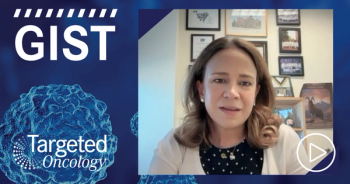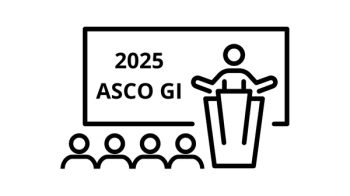
Case 2: Treatment Options in Exon 9–Mutated GIST
Key opinion leaders consider later lines of therapy in metastatic KIT exon 9–mutated GIST and how to monitor and mitigate toxicities.
Episodes in this series

Richard Riedel, MD: Let’s envision that for this particular case the individual receives imatinib for 6 months. They have a maximum response. They undergo primary resection. Then they are continuing imatinib in the adjuvant setting. Mark, you alluded to this depending on the risk features of the tumor, mainly the tumor size, the mitotic rate, the location. This was a tumor greater than 5 cm in the small bowel. I don’t know if we have mitotic rate, but those 2 features would make for a higher risk.
After 9 or 10 months of adjuvant therapy, the patient then subsequently develops metastatic disease to the liver. The patient then proceeds with second-line therapy with sunitinib. They unfortunately progress. They start third-line therapy with regorafenib but have rate-limiting adverse effects. We talked about some of these issues before and some of the challenges with subsequent lines of therapy.
If we can, let’s pause and talk about—particularly for this patient with exon 9 in the metastatic setting— whether you would have done anything differently prior to switching to sunitinib? This was an individual who is on 400 mg in the neoadjuvant setting and then continued on 400 mg daily adjuvantly.
Mark Agulnik, MD: There are so many nuances when you review cases. You see things that pique your interest. When I read 2 new liver metastases, I started to think of what I could do for these liver mets that are different from drug therapy, whether it’s a surgical procedure, radiation, or interventional radiology assisting me with some liver-directed therapy. That’s the first thing I want to explore.
How do you render the patient disease-free or better controlled? We discussed before in this setting with metastatic disease, I don’t love the imatinib at 400 mg, especially for this exon mutation, and therefore, the 800 mg sits better with me.
Richard Riedel, MD: Meg, can you tell me about the role for early dose escalation, at least in the metastatic setting for exon 9 mutation?
Margaret von Mehren, MD: This question was tested in the first studies, the large phase 3 study that looked at imatinib 400 vs 400 mg twice a day. The group of patients who derived the most benefit was the exon 9 patients, because they do seem to do better or to have better disease control within the cell, better control of the kinase activation by the higher dose. That is something I would do if they were still on 400 mg before switching to Sutent.
Jason Sicklick, MD, FACS: We do the same, pump up the dose.
Margaret von Mehren, MD: It’s also interesting to know that with Sutent, there are some people who are advocating using it over imatinib in exon 9 mutations. Because when you look at the studies, Sutent is a very good drug for exon 9 mutations. At this point, I would favor continuing with imatinib, rather than switching directly to sunitinib without making sure we do that dose escalation. But there are some data to support sunitinib being a particularly good drug for exon 9 mutations.
Richard Riedel, MD: In the original phase 3 studies—the 1 in America and the 1 from Europe that were then defined in meta-analysis, referred to as meta–GIST [gastrointestinal stromal tumor]—there was improvement in progression-free survival. I believe there was a trend for overall survival, but it was not statistically significant.
Margaret von Mehren, MD: That is correct.
Richard Riedel, MD: We’ve talked a little about—as we progress through the lines of treatment, from imatinib to sunitinib to regorafenib—some of the challenges with the subsequent lines of therapy. We talked about hypertension. We talked about hand-foot syndrome. Some of these therapies can affect thyroid function. Maybe we can discuss how we monitor and mitigate some of those toxicities associated with later lines of therapy. Mark, how often do you check thyroid function, for example?
Mark Agulnik, MD: Before I answer that, I’ll say that it really highlights the need for a multidisciplinary team. We’ve alluded to the role of oncology pharmacy. We’ve alluded to nursing and advanced practice providers. To get these patients through these treatments as they become more challenging, having a team that understands the nuance of the treatment is important.
With respect to thyroid function, before I start the sunitinib, I do check. I check at 6 weeks, I check at 3 months, and sometimes I don’t check again for 3 months. I always go to the package inserts to look at what I need to do: I test a lot of CBC [complete blood count] for imatinib early on based on the package insert and then the thyroid function obviously for sunitinib. With the ECG [echocardiogram], we’ve talked about the cardiac toxicities associated with it. Certainly, having the team approach for me has been what’s really been able to maintain dose intensity for our patients.
Richard Riedel, MD: Meg, how about in your practice?
Margaret von Mehren, MD: Very similar in terms of the thyroid function. Initially I’ll do it at 6 weeks. If they’re doing OK and not having issues, then I will do it every 3 months with their scans.
Mark Agulnik, MD: Jason, we know that at least in the second- and third-line setting, sunitinib and regorafenib have antiangiogenic properties. We talked about the potential role of surgery for limited progression. On these therapies, how does that affect surgical planning? Do these therapies cause you to think about things differently from a surgical standpoint as opposed to someone who’s on imatinib?
Jason Sicklick, MD, FACS: Yes. In terms of the surgical planning, it doesn’t have a major effect in terms of the toxicities. I will tend to hold them for a little longer preoperatively than I would the imatinib. The 1 thing to consider, though, in terms of making decisions about surgery, is that I will aim to try to do an operation in a patient that is either failing second- or third- or fourth-line therapy. We’ll try to do this when there’s unifocal progression in those types of scenarios, as opposed to multifocal progression. When we see multifocal progression and they’ve been on second- or third-line therapy, I certainly would be less eager to go to surgery and more eager to change the line of therapy.
In terms of bleeding risk or complications with surgery, from my experience I haven’t seen a large difference in terms of postoperative complication between sunitinib or regorafenib and imatinib, although I tend to hold it for a little longer preoperatively than I do with the imatinib.
Richard Riedel, MD: Meg, you had mentioned early on that many of these patients are fit and they can move on to multiple lines of therapy. What are some of the challenges in treating patients in the multiple-therapy relapse or refractory setting?
Margaret von Mehren, MD: One challenge is we know that these tumors are not 1 uniform type, that they have a variety of mutations. When we assess response, we’re more likely to see mixed responses. It takes a little more judgment in terms of making a decision. Do we stop a medication or do we continue it? Do we really need to change therapy or not?
For me, that’s 1 reason why I value being able to look at my scans personally and look at what is actually happening. Because all too often, if you read a scan report that says progression, you may be doing a patient a disservice. If they have a small area of progression in 1 area but the bulk of their disease is being controlled, the you’re ending at therapy that they’re actually benefiting from. That’s just an important component of what I do when I care for my patients.
Richard Riedel, MD: I routinely will tell our trainees, “Always look at your own imaging,” just for that reason. You can’t get a sense of the full picture without looking at the imaging. While mixed responses can be challenging, to your point, if someone has 90% of their disease controlled and there’s limited progression, that’s not someone that I’d be inclined to remove from therapy. To Mark’s point, I would look for ways to address the limited progression, either with radiology techniques, for example, or as we’ve talked about a couple of times, surgical strategies.
Transcript edited for clarity.













































